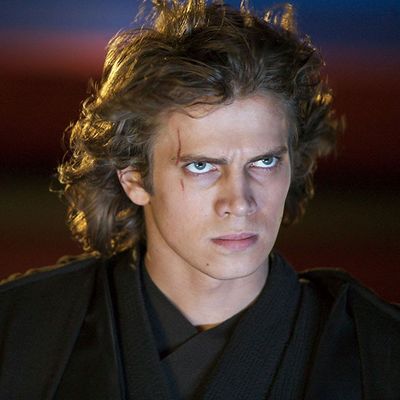

In the lead-up to Star Wars: The Last Jedi, we look back at the first Jedi (narratively speaking) with a series of stories about the much-beloved and never-disparaged prequel trilogy.
There are certain criticisms of Star Wars:Episodes I, II, and III that have been repeated so often, they’re basically accepted as part of Star Wars mythology.
Things like: The prequels were CGI’d to death. Midi-Chlorians are an abomination. Jar Jar Binks is the absolute worst. Also: Hayden Christensen is a bad actor, based on his performances in Attack of the Clones and Revenge of the Sith.
Say what you will about the CGI, the Midi-Chlorians, or Jar Jar, whose intolerability has not lessened with the passage of time. But Christensen? That guy deserves a break for a whole bunch of reasons.
I spent some time this week revisiting both Attack of the Clones and Revenge of the Sith — you’re welcome, America — and was reminded again of those films’ flaws, which include performances (and not just from Christensen) that often, though by no means always, feel stilted.
Clones is the most blatant offender in this area, which is why I believe Christensen has taken such an unfair brunt of prequel blame. Unlike his co-stars Natalie Portman or Ewan McGregor, audiences barely knew who Christensen was when he snapped on Anakin Skywalker’s Padawan ponytail. His most notable credit prior to Star Wars was the small film Life As a House, which I think it’s fair to say that large swaths of the fan base did not see.
Episode II marked Christensen’s introduction to movie audiences in general, and to the Jedi realm, where he was finally showing us what Darth Vader, one of the great all-time movie villains, looked like in grown-up form, before he became Darth Vader. Even if he hadn’t gone to the dark side yet in Clones, one expected pre-Darth to have a powerful, teasingly sinister presence. Instead he is pouty, petulant, overcome by love for Amidala (Portman), and, perhaps most surprisingly, operating on a mostly low key throughout the movie. Seeing The Last Jedi and then going back to watch Attack of the Clones is like going from a Tesla driving at 150 miles per hour to an old Cadillac that can barely climb a hill where the speed limit is 25. Christensen’s performance is representative of the film’s excessive formality and deliberate pacing. But that formality and slowness is also what George Lucas was going for as a director.
“I made the film in a 1930s style,” Lucas told the Guardian in 2002, as Clones was on the verge of its premiere. “It’s based on a Saturday matinee serial from the 1930s, so the acting style is very ’30s, very theatrical, very old-fashioned. Method acting came in in the 1950s and is very predominant today. I prefer to use the old style.”
Christensen, a young actor in his first exceedingly major motion picture, was simply trying to give his legendary director what he wanted. “Because you are cast as this character that is the connective tissue to someone who represents all that is evil … your natural instinct is to try to take him there,” Christensen told ThoughtCo. in 2005. “George [Lucas] was constantly asking me to pull back from that and to make him someone who is struggling and someone who allows his frustrations to present themselves in ways that aren’t necessarily perceived as evil but may be in other ways. And to keep it at that and to not really show any sort of a character arc in Episode II because it was more about who he was at that time in his life.”
In short, Christensen kept his emotions dialed down on purpose, in ways that may have been detrimental to the film, depending on your perspective, but that matched his director’s vision. That vision also includes some of the worst dialogue in the entire Star Wars canon. There’s Anakin’s dreadful “I hate sand” monologue, and his profession of love for Amidala that includes the sentence, “I’m haunted by the kiss that you should never have given me.” And yet: Go back and watch that “haunted by the kiss” confession scene in Clones again. The words are still cringe-y, but Christensen delivers them with such sincerity that he almost — almost! — overcomes them.
In between Clones and Sith, another, much less high-profile film starring Christensen was released: Shattered Glass, a tick-tock tracking of the self-imposed destruction of the serial fabricator/journalist Stephen Glass. It’s an excellent movie, one worth revisiting at a time when the term “fake news” is used so casually and inaccurately. It also features a terrific performance by Christensen as Glass, who is persuasively likable, weak, arrogant, and panicked, often in the same scene. Critics at the time uniformly praised his work in the movie. The New York Times’ A.O. Scott said Christensen found “the perfect balance between creepiness and charm,” while David Edelstein, then writing for Slate, wrote, “The performances of Christensen, [Chloë] Sevigny, [Hank] Azaria, and especially Peter Sarsgaard as a prissy yet achingly vulnerable Chuck Lane are so good that for long stretches the artifice drops away and you think you’re watching a fly-on-the-wall documentary.” Shattered Glass is 95 minutes’ worth of proof that Hayden Christensen can, in fact, act.
I’d also say that Revenge of the Sith provides much more solid proof of that as well, in part because it’s a better movie than Attack of the Clones and finally allows Anakin (and Christensen) to lean hard into that dark side transition. Christensen seems to have his bearings to a greater degree in it, perhaps because he went through the “Jedi training” Clones provided. He’s more confident, and his scenes with Portman feel more natural than the ones in Episode II. He’s also able to rattle loose more emotion in this chapter of the narrative, which surely must have been a relief after reigning it in during Episode II. Is Sith a perfect movie? No, not at all. But it’s certainly the best of the prequel trilogy, largely because it finally delivers what we sat through hours of Jedi council meetings to see: Anakin finally putting on that iconic mask and becoming the mouth-breathing bad guy with the voice of James Earl Jones. Christensen deserves at least some credit for making that transition credible.
So is the upshot of this piece that Christensen isn’t to blame for his performance because it’s all George Lucas’s fault? I mean … sort of? But it’s also become so easy to dump on Lucas for the prequels’ shortcomings, and his frequently noted issues with the acting side of directing, that it feels both cliché and reductive to leave it there. The fact is that Lucas made exactly the movies he wanted to make in The Phantom Menace, Attack of the Clones, and Revenge of the Sith, and told a story that sounded worthy of telling: what turns a Jedi into a dark lord. I completely understand why Lucas wanted to explore that terrain and why, if you remember 1999 and early 2000s, fans were genuinely excited to see that story play out, even, I might add, after Jar Jar Binks meesa yousa’d his way into the public consciousness.
The problem with that arc is that it requires audiences to absorb six-plus hours of movie, only to watch the protagonist travel down the worst possible path. We don’t go to the movies to see happy endings all the time time necessarily. But I would argue that we do go to Star Wars movies for uplift, something the original trilogy and the more recent films have provided in spades because it’s baked into their stories of rebellion and hope, and overcoming those who seek to stanch both. This is something that the universe’s creator, who was looking to the ’30s serials that inspired him when he was young, can’t necessarily grasp in the same way that filmmakers like J.J. Abrams or Rian Johnson can, who are inspired not by serials, but by A New Hope, The Empire Strikes Back, and Return of the Jedi, two of which were not directed by Lucas.
In The Force Awakens and The Last Jedi, Adam Driver is essentially playing another version of Anakin in the form of Kylo Ren, and he’s electrifying to watch, especially in Last Jedi. He may be a better actor than Christensen – he’s certainly had more and better opportunities to prove that – but he also is playing someone who, while conflicted, has already proven himself to be potentially evil. Both Abrams and Johnson have allowed him to embrace that in a way that Christensen could never fully do until the final act of Sith. While that doesn’t excuse every off Anakin moment in, say, Attack of the Clones — I’m sorry, the thing with the sand is still bad on every level — it does help to explain it. Most actors, even accomplished ones like Leonardo DiCaprio, who Lucas approached about playing Anakin, would have had a hard time bringing that character to life within the framework necessitated by that story and the way Lucas wanted to tell it. Perhaps that’s why DiCaprio passed on the project.
Hayden Christensen is still a working actor, though none of his recent credits are particularly notable. The cloud that hangs over the prequels no doubt still hangs over him every time he expresses interest in or auditions for a part. Which is a lie about his potential as an actor — not one that’s quite as egregious as the ones Stephen Glass told at the New Republic, but a lie nonetheless. What the Force gave to Hayden Christensen nearly 20 years ago, it also took away.


